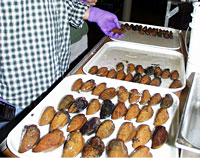|
|
Interviews: Chief Scientist Cindy Van Dover
Cindy Van Dover has probably spent more time visiting hydrothermal vents than any other scientist - simply because she is the only scientist, and the only woman, ever to have completed the rigorous training required to become a pilot of Alvin, the Woods Hole submersible. In her book Deep-Ocean Journeys, Van Dover recounts some of her seafloor adventures.
Question:
How did your parents respond to your becoming an oceanographer? Cindy: They would have preferred I had a child. But they responded very well - they thought it was exciting. My mom was not too keen on my becoming an Alvin pilot though. She always worried about me. Question: What made you decide you needed to do that? Cindy: It began when I was a graduate student and hardly got to dive in the sub at all. It took me several cruises. And yet I’m an ecologist, and as an ecologist you want to be in the environment you’re studying. How can you be an ecologist or a natural historian if you can’t be out there studying nature? The people who dive every day or every other day are the pilots. And then I was just in love with the idea of being a sailor. Good Lord! Being an Alvin pilot was something I’d never imagined to be possible. Nor did anyone else think it was possible. Some of the big things I’ve done have been because somebody didn’t think I could do it, whether it was myself or somebody else. And with Alvin a lot of it was I didn’t think I could do it. So it was proving myself. Question: In your book you say you were only scared once when you were piloting Alvin. Why only once? And why not, for instance, that time in 1991 when the sub got stuck in some seafloor mud? Cindy: Because when you’re an Alvin pilot, you know your vehicle really well. You know all the different safety features, and all the different ways you can get out of trouble. So getting stuck in the mud was just not a big deal - there were so many things that I could do. Having a pile of rocks fall on me, though, that would spook me, for sure. That’s when I was scared - when I was down in a crevice, and I imagined that there might be an earthquake. All those different safety features wouldn’t have helped. Question: Of the many cruises you’ve been on, which one sticks out in your memory? Cindy: The first one: it changed my life. That was an ’82 cruise called the Oasis expedition, to 21 degrees North on the East Pacific Rise. I was unemployed, I was not a graduate student, I was just hanging out in Ithaca, New York with my boyfriend at the time. And I didn’t even know what a ship was. I had no idea...I flew into San Diego, first time I had ever flown across country, and found the ship at the dock, and walked up the gangway - oh gosh, it was just heaven. Question: What about this cruise? What is special about this place you’re taking us to? Cindy: We’ve never been there before. The ridges in the Indian Ocean have been a big question mark for biology. So, who’s here? What species are here? You know Marlow, in Conrad’s Heart of Darkness, the guy who’s the narrator? Just in the beginning of the book he talks about liking maps, and looking at maps. Back then the blank spaces were on the continents. He’d just kind of look at these blank spaces, and point to somewhere, and he’d say ‘when I grow up, I will go there.’ For me, looking at the mid-ocean ridge system - I walk around with this image of all the ridges in my mind all the time. And there are just these big voids. And I think, ‘When I grow up, I will go there.’
|
|||
Mailing List | Feedback | Glossary | For Teachers | About Us | Contact
© 2010 Dive and Discover™. Dive and Discover™ is a registered trademark of
Woods
Hole Oceanographic Institution
